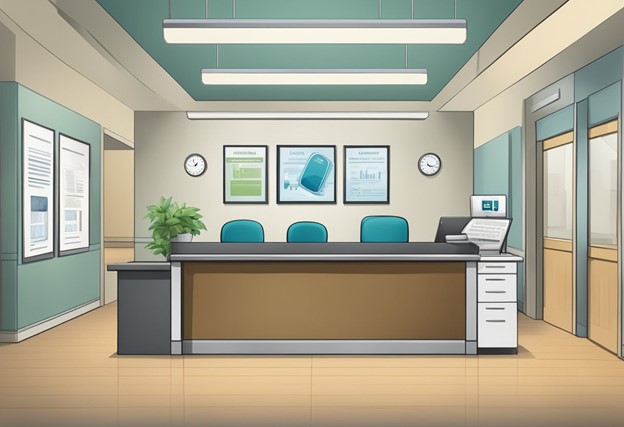

Have you ever wondered how hospitals manage to keep their doors open and equipment up-to-date, even when money gets tight?
Medical receivables financing is the strategy behind this financial resilience. Also referred to as healthcare factoring, it helps healthcare providers maintain stability by unlocking cash flow tied up in unpaid insurance claims.
Facilities like clinics and urgent care centers often experience delays in reimbursement from insurers. This waiting period can make it challenging to invest in new equipment or cover everyday expenses.
With medical receivables financing, providers sell their outstanding invoices to a third-party financing company for immediate working capital. This allows them to continue operating smoothly and prioritize what truly matters—quality patient care.
This smart approach ensures that healthcare organizations stay financially healthy, scale without taking on debt, and maintain focus on delivering top-notch medical services.

Managing financial resources is crucial for healthcare providers, especially when acquiring essential equipment. Medical equipment financing enables practices to obtain advanced technology without bearing the full cost upfront.
This strategy complements medical receivables financing by preserving working capital while meeting operational needs.
Common financing options include:
When considering leasing, we gain the ability to use equipment without owning it, often with lower monthly payments than purchasing.
The key decision factors here include tax implications, technology obsolescence, and capital availability.
On the other hand, purchasing gives us full control and ownership from day one, and it means we do not have to worry about the constraints of a lease agreement.
| Option | Pros | Cons |
|---|---|---|
| Leasing | Lower upfront costs, easy upgrades | No ownership |
| Purchasing | Full control and long-term asset value | Higher initial investment |
Both financing and leasing have distinct advantages that can ease the financial burden on healthcare practices.
Financing allows us to spread the cost of expensive equipment over time, helping maintain a steady cash flow, which is crucial for operational stability.
With leasing, we gain access to equipment without substantial capital outlay, which can be quite attractive for practices needing to preserve cash for other aspects of their operations.

When we talk about preserving capital for our medical practice, leasing is a strategic choice that allows us to maintain liquidity while still acquiring the necessary assets for our operations.
Leasing has a direct and positive impact on cash flow management for healthcare providers.
By choosing to lease equipment rather than purchase it outright, we ensure immediate funding for medical practices without a significant upfront investment.
This approach:
For financing cash-strapped medical practices, leasing is a powerful tool to aid in budgeting and forecasting.
The structured nature of lease payments helps us:

In today’s digital healthcare landscape, staying current with medical technology is essential. Financing and leasing—alongside medical receivables financing—help ensure upgrades are possible without financial strain.
Get Fast Funding with Medical Receivables Financing. Apply now and improve your clinic’s cash flow in 24–48 hours.
In our field, obsolete equipment isn’t just about falling behind on trend, it’s a direct blow to our operational efficiency and financial viability.
We must regularly assess our hardware and software to identify any tools that no longer meet industry standards or our clients’ expectations.
For example, an outdated billing system may slow down our ability to process claims, leading to delayed reimbursements and a strain on our cash flow.
Our commitment to continuous upgrades is evidenced by integrating Robotic Process Automation (RPA) to reduce manual errors and improve claim turnaround times.
This not only ensures our medical billing processes are streamlined but also that we are equipped to adapt to any changes in regulations or payer policies swiftly.
As we adopt enhancing efficiency and accuracy in our systems, we boost our ability to leverage healthcare practice financing options, ensuring we stay ahead and secure in the financial aspect of our practice.

In the world of medical accounts receivable funding, the advantages go far beyond short-term cash boosts.
We focus on delivering reliable cash flow solutions to healthcare providers through medical receivable loans for clinics, ensuring they maintain their fiscal health as efficiently as they care for their patient’s physical health.
When we engage in healthcare receivables factoring, we may see potential tax benefits.
Since the transaction is often considered as a sale of assets, the cash received can sometimes be tax-free in the year it is received.
We advise clinics to consult with their tax professionals to understand the specific tax implications of these transactions.
By utilizing medical receivable loans and funding, we witness an immediate positive impact on our balance sheets.
A quick infusion of cash translates into reduced accounts receivable and an increase in available working capital.
Moreover, it elevates our financial profile when we negate the need to carry long-term debt on our books.
This strategic financial maneuver through medical accounts receivable funding bolsters our balance sheet, offering us more flexibility and stability for future financial planning.

To maximize the benefits of medical receivables financing, selecting the right partner is critical.
We must compare providers thoroughly and evaluate terms and conditions meticulously to ensure we select the best path for our revenue cycle financing needs.
Experience in Healthcare: We look for receivables financing companies that specialize in the healthcare industry.
Their understanding of our unique billing cycles and regulatory environment is paramount.
Table 1: Provider Comparison
| Provider | Years in Healthcare Financing | Client Testimonials | Advanced Rate |
| A | 10 years | Positive | 80% |
| B | 3 years | Mixed | 75% |
| C | 15 years | Highly Positive | 85% |
Technology and Support: We assess the level of technology support they offer, such as automated claim submissions, and the quality of their customer service.
Efficient and responsive support is crucial for seamless operations.
List of Must-Haves:
Fees and Rates: We must understand the fee structure. Transparent and reasonable factoring fees are critical for maintaining profitability.
Flexibility: Terms should allow for flexible funding amounts that grow with our practice.
Contracts should not constrain us but rather provide a lifeline when we’re in need of quick access to funds.
Key Contract Parameters:

To wrap things up, medical receivables financing is like a life vest for healthcare practices swimming in the deep waters of financial challenges. It turns waiting bills into instant cash, helping clinics and hospitals stay up and running.
By choosing healthcare factoring, these providers can make smart choices faster, without sitting around waiting for insurance money.
This strategy keeps financial health strong and avoids the trouble of delayed payments. It’s a powerful tool to keep healthcare services thriving.
So, how can your local healthcare providers benefit from this approach? Have you or someone you know experienced the impact of quicker funding in healthcare?
What qualifications must a practice meet to be eligible for medical receivables financing?
To be eligible for medical receivables financing, our healthcare practice typically needs to have a steady volume of claims with third-party payers like Medicare, Medicaid, HMOs, and private insurance companies.
Creditworthiness and a history of consistent billing practices are also key factors.
How can healthcare providers in the USA leverage receivables financing to manage cash flow?
Healthcare providers in the USA can manage cash flow by converting outstanding invoices into immediate working capital through receivables financing.
This is particularly useful in bridging the gap between service delivery and payment receipt.
Can you outline the main types of receivable financing available to medical practices?
The main types of receivable financing available to medical practices include traditional factoring, where invoices are sold to a third party, and asset-based lending, which involves using receivables as collateral for a loan.
What is the typical process involved in accounts receivable financing for healthcare businesses?
The typical process involves our practice of selling its accounts receivable at a discount to a financing company, which then provides us with an immediate cash advance.
Afterward, the finance company collects the payments from third-party payers, deducts its fees, and reimburses the remainder to us.
How does accounts payable financing differ from accounts receivable financing in a clinical setting?
Accounts payable financing, or reverse factoring, involves our practice of receiving funding to pay off suppliers early, while accounts receivable financing involves selling our outstanding invoices for immediate cash. The former manages outgoing cash, and the latter improves incoming cash flow.
What are the key differences between traditional factoring and accounts receivable financing for medical services providers?
For medical services providers, the key differences lie in the terms of the agreement.
Traditional factoring typically involves a full sale of the invoices and more control on the part of the factor. Meanwhile, accounts receivable financing might offer more flexible arrangements, such as selective invoicing and potentially lower fees.